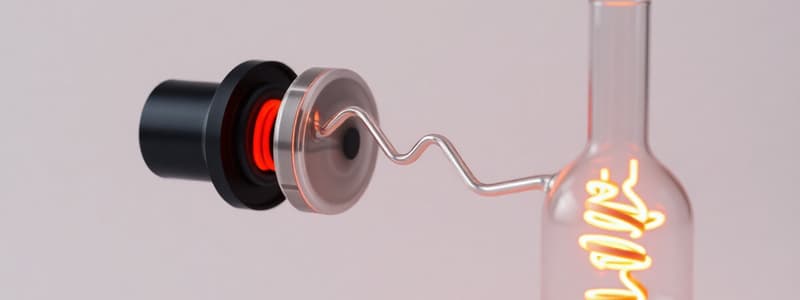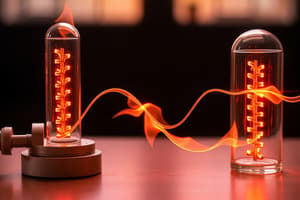Podcast
Questions and Answers
What does the Zeroth Law of Thermodynamics imply about thermal equilibrium?
What does the Zeroth Law of Thermodynamics imply about thermal equilibrium?
It implies that if two systems are each in thermal equilibrium with a third system, then they are in thermal equilibrium with each other.
According to the First Law of Thermodynamics, what does the equation $\Delta U = Q - W$ represent?
According to the First Law of Thermodynamics, what does the equation $\Delta U = Q - W$ represent?
It represents that the change in internal energy of a system is equal to the heat added to the system minus the work done by the system.
Explain the concept of entropy and its significance in the Second Law of Thermodynamics.
Explain the concept of entropy and its significance in the Second Law of Thermodynamics.
Entropy is a measure of disorder or randomness in a system, and the Second Law states that entropy in an isolated system always increases over time.
What is the behavior of a perfect crystal's entropy as its temperature approaches absolute zero, according to the Third Law of Thermodynamics?
What is the behavior of a perfect crystal's entropy as its temperature approaches absolute zero, according to the Third Law of Thermodynamics?
Differentiate between an open system and a closed system in thermodynamics.
Differentiate between an open system and a closed system in thermodynamics.
In the context of refrigeration, what does the coefficient of performance (COP) represent?
In the context of refrigeration, what does the coefficient of performance (COP) represent?
What defines the efficiency of a heat engine, and how is it mathematically expressed?
What defines the efficiency of a heat engine, and how is it mathematically expressed?
What is the significance of specific heat capacity in thermodynamics?
What is the significance of specific heat capacity in thermodynamics?
Define an adiabatic process and its key characteristic regarding heat exchange.
Define an adiabatic process and its key characteristic regarding heat exchange.
What is latent heat, and why is it important in phase changes?
What is latent heat, and why is it important in phase changes?
Study Notes
Thermodynamics
-
Definition: Branch of physics dealing with heat, work, temperature, and energy transfer.
-
Laws of Thermodynamics:
- Zeroth Law: If two systems are in thermal equilibrium with a third system, they are in thermal equilibrium with each other.
- First Law: Energy cannot be created or destroyed, only transformed. ( \Delta U = Q - W ) (Change in internal energy = Heat added - Work done by the system).
- Second Law: Heat cannot spontaneously flow from a colder body to a hotter body. Entropy of an isolated system always increases.
- Third Law: As temperature approaches absolute zero, the entropy of a perfect crystal approaches zero.
-
Key Concepts:
- Internal Energy (U): The total energy contained within a system.
- Heat (Q): Energy transferred due to temperature difference.
- Work (W): Energy transferred when an object is moved by a force.
- Entropy (S): Measure of disorder or randomness in a system.
-
Processes:
- Isothermal: Constant temperature (Q = W).
- Adiabatic: No heat exchange (Q = 0).
- Isochoric: Constant volume (W = 0).
- Isobaric: Constant pressure (Q = ΔU + PΔV).
-
Thermodynamic Systems:
- Open System: Exchanges both matter and energy with surroundings.
- Closed System: Exchanges energy but not matter.
- Isolated System: Does not exchange either matter or energy.
-
Heat Engines:
- Convert heat energy into work.
- Efficiency (( \eta )) defined as ( \eta = \frac{W_{out}}{Q_{in}} ).
- Carnot Engine: Idealized heat engine operating between two reservoirs, maximum efficiency is determined by temperatures of hot ( (T_H) ) and cold ( (T_C) ) reservoirs: ( \eta = 1 - \frac{T_C}{T_H} ).
-
Refrigerators and Heat Pumps:
- Designed to transfer heat from a cold reservoir to a hot reservoir.
- Coefficient of performance (COP) measures efficiency:
- For refrigerators: ( COP_{refrigerator} = \frac{Q_{cold}}{W} ).
- For heat pumps: ( COP_{heat pump} = \frac{Q_{hot}}{W} ).
-
Applications:
- HVAC systems, engines, refrigerators, and thermoelectric devices.
-
Key Terms:
- Thermal Equilibrium: State where two bodies reach the same temperature.
- Specific Heat Capacity: Amount of heat required to change the temperature of a unit mass by one degree.
- Latent Heat: Heat required for phase changes without temperature change (e.g., melting, boiling).
Thermodynamics Overview
- Branch of physics focusing on the relationships between heat, work, temperature, and energy transfer.
Laws of Thermodynamics
- Zeroth Law: If two systems are in thermal equilibrium with a third, they are in equilibrium with each other.
- First Law: Energy conservation principle; it can be transformed but not created or destroyed. Expressed as ( \Delta U = Q - W ) (Change in internal energy equals heat added minus work done).
- Second Law: Heat naturally flows from hot to cold, increasing the entropy of isolated systems over time.
- Third Law: Entropy of a perfect crystal approaches zero as temperature nears absolute zero.
Key Concepts
- Internal Energy (U): Total energy within a system, including kinetic and potential energies of particles.
- Heat (Q): Energy transfer resulting from temperature differences.
- Work (W): Energy transfer linked to the movement of an object against a force.
- Entropy (S): Quantifies disorder or randomness in a system, determining the direction of thermodynamic processes.
Thermodynamic Processes
- Isothermal Process: Occurs at constant temperature; the heat added equals the work done.
- Adiabatic Process: No heat is exchanged; all energy change results from work done on or by the system.
- Isochoric Process: Volume remains constant; no work is done.
- Isobaric Process: Pressure remains constant; heat added is related to changes in internal energy and volume.
Thermodynamic Systems
- Open System: Exchanges matter and energy with surroundings.
- Closed System: Exchanges energy but not matter.
- Isolated System: Exchanges neither matter nor energy.
Heat Engines
- Convert thermal energy into mechanical work, with efficiency ( \eta = \frac{W_{out}}{Q_{in}} ).
- Carnot Engine: Theoretical engine operating between temperature reservoirs; maximum efficiency defined by ( \eta = 1 - \frac{T_C}{T_H} ).
Refrigerators and Heat Pumps
- Designed to move heat from a cold reservoir to a hot reservoir.
- Coefficient of performance (COP):
- For refrigerators: ( COP_{refrigerator} = \frac{Q_{cold}}{W} ).
- For heat pumps: ( COP_{heat pump} = \frac{Q_{hot}}{W} ).
Applications
- Utilized in HVAC systems, internal combustion engines, refrigeration units, and thermoelectric devices.
Key Terms
- Thermal Equilibrium: Condition when two systems reach the same temperature, ceasing net heat transfer.
- Specific Heat Capacity: Heat energy required to raise the temperature of a unit mass by one degree.
- Latent Heat: Energy necessary for phase changes (e.g., melting, boiling) without changing temperature.
Studying That Suits You
Use AI to generate personalized quizzes and flashcards to suit your learning preferences.
Description
Explore the fundamental concepts and laws of thermodynamics, including the Zeroth, First, Second, and Third Laws. This quiz will test your understanding of internal energy, heat, work, and entropy, essential for grasping the principles of energy transfer and equilibrium in physical systems.




